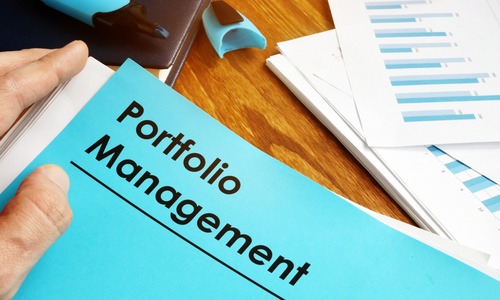Every firm that competes in the market must continually create effective strategies and plans of action that can produce favourable outcomes for the organization. Therefore, to achieve this, it is essential to have concepts, processes, and tools that are genuinely effective and add to the knowledge of experts, teams, leaders, and managers. One of these concepts is portfolio management, which refers to employing the appropriate employees and technological resources to execute projects and improve business performance.
Jump ahead to
What is Portfolio Management?
A project portfolio is a collection of projects that are coordinated and optimized for an organization’s operational and financial goals. Project Portfolio Management (PPM) analyses and manages the costs, resources, technology, and procedures for all the projects and programs within a portfolio. The main purpose of project portfolio management is to ensure that all portfolio outcomes satisfy the organization’s strategic goals and business objectives. Portfolio management process involves selecting, prioritizing, and controlling these projects through centralized management systems.

Portfolio Management Process
The following steps play a vital role in Portfolio Management:
Define Goals
Establishing goals is the first step in efficient portfolio management. Professionals first need to understand the organization’s business objectives and strategic goals. The objective is to align the project portfolio with the organization’s strategic strategy. One of the most popular ways to create that alignment is to make a detailed strategy map that describes the business objectives and recommends how team members should prioritize them.
Collect Project Ideas for the Portfolio
Start creating the portfolio after outlining the strategic goals. In order to create a portfolio, professionals should gather projects. These could be active projects or concepts sufficiently similar to be handled concurrently. Professionals should assemble project management data, then make the evaluation criteria to select the best.
Select the Best Projects for the Portfolio
Professionals must do a cost-benefit analysis and utilize the valuation criteria in order to decide which projects are the best candidates for the portfolio. This valuation criterion will gauge the value each project contributes to the portfolio.
Validate Project Portfolio Feasibility
Professionals should do a feasibility analysis that considers all financial risks, capacity planning, and resource management limits after selecting the best projects that match the portfolio. They should create a more accurate assessment of the resources required to finish a project and any possible challenges. Following that, they can allocate resources and proceed if the idea still looks feasible.
Manage and Monitor the Portfolio.
Professionals must collaborate with project and program managers to coordinate the parallel execution of the projects and programs in the portfolio after projects have started. They should manage tasks including re-scoping, resource reallocation, and regular portfolio reviews.
Why Do You Need Portfolio Management?
Good PPM practices add depth and maturity to organizations by introducing a harmonized approach to managing projects at scale. Organizations with established portfolio management procedures successfully complete 35% more programs, experience fewer program failures, and incur less financial loss. It also helps them to benefit from greater transparency, up-to-date investment data, and real-time project statuses. As a result, customer satisfaction has increased in the organization.
PPM promotes a cooperative rather than a competitive environment within the business, which boosts resource effectiveness. It frees up resources to concentrate on other goals, like enhancing customer service or ROI.
What Is The Role Of a Project Portfolio Manager?
Project portfolio managers are responsible for managing the portfolio of active projects, including accepting or rejecting project and program proposals. They are in charge of accomplishing their organization’s goals and objectives and a return on investment. Moreover, they know the project’s limitations imposed by organizational restraints, including a budget, timeline, infrastructure, and people.
In contrast to project managers, portfolio managers are more concerned with project selection than task breakdown. In other words, a project manager handles the “how,” but a project portfolio manager is focused on the “what” and “which.” The project portfolio manager may be responsible for overseeing one or more portfolios. Project portfolio managers work with the PMO to guide the project management approaches to be employed, such as a traditional waterfall or an agile framework.
Conclusion
The project portfolio management process keeps projects aligned with strategic corporate goals well-organised by outlining how the organization manages project ranking, resource distribution, planning, and development. Professionals interested in learning about project portfolio management can enrol in PMP Certification Training. Training helps to gain an in-depth knowledge of the latest project management practices. Additionally, they help obtain real-world experience using project management methods within an organization.



